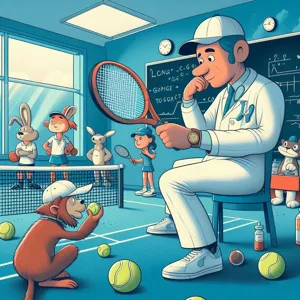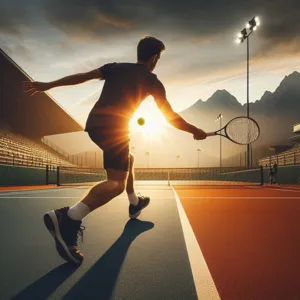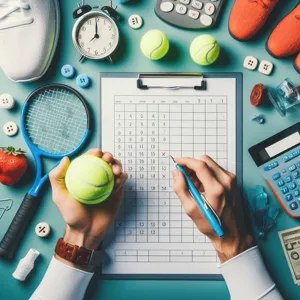Tennis is a game of precision, strategy, and mental fortitude, and mastering the baseline is key to elevating your performance on the court.
Whether you’re a novice player looking to improve your skills or a seasoned competitor aiming to refine your technique, understanding the nuances of baseline play can transform your game. The baseline is your launchpad, where powerful groundstrokes and tactical shot placements come into play, allowing you to dictate the pace of the match. In this blog post, we’ll explore top strategies that will not only enhance your baseline game but also elevate your overall performance. From footwork and positioning to shot selection and mental resilience, we’ll cover essential tips that will empower you to take control of the court, outmaneuver your opponents, and ultimately achieve that satisfying victory. Get ready to dig deep, rally hard, and master the art of baseline play!
1. Understanding the Importance of the Baseline in Tennis

The baseline is more than just a line on the court; it serves as a pivotal foundation for nearly every aspect of your game. Positioned at the back of the court, the baseline marks the dividing line between offense and defense, dictating the flow of play and the range of your shots. Understanding its importance can transform your approach to the game, allowing you to harness its power to elevate your performance.
When you’re positioned at the baseline, you gain a strategic advantage, allowing you to dictate the pace of the match. It’s a space that provides the necessary distance to execute powerful groundstrokes while giving you ample time to react to your opponent’s shots. Mastering your positioning here can lead to more consistent rallies and a stronger ability to maneuver your adversary around the court. Additionally, being comfortable at the baseline enables you to generate topspin and slice, adding variety to your shots that can catch your opponent off guard.
The baseline also plays a crucial role in your overall court awareness. As you develop your game, you’ll learn to read your opponent’s body language and anticipate their next move based on their position relative to the baseline. This heightened awareness can help you create opportunities for aggressive plays, such as stepping into the court to hit a volley or a well-placed approach shot.
Furthermore, understanding the baseline allows you to implement effective strategies for both singles and doubles play. In singles, controlling the baseline means keeping your opponent on the defensive, while in doubles, it helps you set up advantageous positions and angles for quick exchanges.
In conclusion, the baseline is not merely a reference point; it is the heart of your strategy and execution in tennis. By appreciating its significance and honing your skills around it, you’ll find yourself not only improving your game but also enjoying the sport at a deeper level. Embrace the baseline, and watch as your confidence and performance soar on the court.
2. Key Techniques for Effective Baseline Play
When it comes to mastering your baseline play, a solid understanding of key techniques can make all the difference in your performance on the court. At this pivotal position, you have the unique opportunity to dictate the pace and direction of the game, so honing your skills is essential for elevating your overall performance. Here are some crucial techniques to incorporate into your training regimen:
**1. Footwork Fundamentals:** The foundation of effective baseline play lies in your footwork. Quick, agile movements enable you to position yourself optimally to hit each shot. Practice lateral shuffles, explosive sprints, and quick stops to improve your ability to move in and out of your shots. Visualize your opponent’s shots as you practice, allowing your feet to respond instinctively to different angles and speeds.
**2. Consistent Groundstrokes:** Your groundstrokes are your primary weapons from the baseline. Focus on creating a consistent swing that blends power with accuracy. Work on your forehand and backhand strokes separately, paying attention to grip, stance, and follow-through. Drills that emphasize hitting targets can be particularly effective, helping you develop precision while maintaining the ability to generate topspin and depth.
**3. Varying Spin and Pace:** One of the hallmarks of an effective baseline player is the ability to mix up spin and pace. Experiment with topspin, slice, and flat shots to keep your opponent guessing. Incorporating different spins not only makes your shots more challenging to return but also helps you adapt your game based on your opponent’s weaknesses.
**4. Anticipation and Court Awareness:** Effective baseline play isn’t just about your shots; it’s also about anticipating your opponent’s next move. Train yourself to read the game by observing your opponent’s body language and racket positioning. This awareness allows you to position yourself well in advance, setting you up for a better return and giving you the edge in rallies.
**5. Mental Resilience:** Finally, don’t underestimate the importance of mental resilience. Baseline rallies can be physically demanding and mentally draining. Cultivate a strong mental game through visualization techniques and mindfulness practices. Staying focused and composed during long rallies will not only enhance your performance but will also help you capitalize on critical points in the match.
By integrating these key techniques into your training, you’ll be well on your way to mastering the baseline and taking your tennis game to new heights. Remember, consistency and practice are your best friends on this journey, so stay dedicated, and watch your skills flourish!
3. Developing a Strong Groundstroke

Developing a strong groundstroke is fundamental to elevating your tennis game and can be a game-changer on the court. A well-executed groundstroke not only helps you establish control over rallies but also allows you to dictate the pace of the match. To master this essential skill, focus on three key areas: technique, consistency, and power.
**Technique** is the cornerstone of a strong groundstroke. Start with your grip; the semi-western grip is popular for its versatility in generating topspin. Position yourself with your feet shoulder-width apart and knees slightly bent, ready to pivot as the ball approaches. As you prepare to hit, turn your shoulders and pull your racket back, ensuring you maintain a balanced stance. When the ball comes to you, aim for a smooth, fluid motion—step into your shot, making contact with the ball in front of your body. Follow through fully, allowing your racket to finish high, which enhances the spin and trajectory of the shot.
**Consistency** is key to developing confidence on the court. Practice your groundstrokes regularly, focusing on hitting the same spot repeatedly. Use drills that emphasize hitting cross-court shots, as this increases your margin for error and helps you develop a rhythm. The more you practice, the more automatic your strokes will become, allowing you to react instinctively during matches. Consider incorporating targets on the court to hone your accuracy; hitting a specific area not only sharpens your aim but also prepares you to adapt to different match situations.
**Power** is the final piece of the puzzle. While it’s essential to hit with precision, adding power to your groundstrokes can give you a competitive edge. Strength and conditioning workouts that focus on your core, legs, and upper body will enhance your overall power. Additionally, work on generating racquet head speed through your stroke. The faster your racket moves through the air, the more pace you can impart on the ball. Experiment with your stance and swing mechanics to find what gives you the best combination of control and power.
By focusing on these foundational aspects—technique, consistency, and power—you will develop a strong groundstroke that not only enhances your performance but also instills confidence as you face your opponents. Remember, mastery takes time and dedication, so be patient with yourself and enjoy the process of improvement. Your groundstrokes will become a formidable weapon in your arsenal, allowing you to dominate the baseline and elevate your entire game.
4. Footwork Fundamentals: Positioning for Success
Footwork is the unsung hero of a successful tennis game. While many players focus on perfecting their serves or mastering their backhands, the foundation of every great shot relies heavily on effective movement on the court. Proper footwork not only enhances your ability to reach the ball, but it also positions you for optimal shots, allowing for better control and power.
To begin mastering your footwork fundamentals, consider the importance of balance and agility. Start by practicing the ready position: feet shoulder-width apart, knees slightly bent, and weight evenly distributed. This stance prepares you to react quickly, whether you’re moving forward to the net or back to the baseline. As the ball approaches, utilize small, quick steps to adjust your position rather than large strides, which can throw off your balance and timing.
Incorporating drills into your training routine can significantly improve your footwork. Ladder drills, cone sprints, and shadow swings help develop your speed and coordination. Focus on your foot placement and ensure that you’re always moving with purpose. Remember, good footwork is about efficiency; the quicker you can get into position, the more time you have to set up your shot.
Additionally, practice lateral movements, as tennis is a game of angles. Being able to glide smoothly side to side will not only keep you agile but also allow you to cover the court more effectively. Engaging in exercises that enhance your lateral speed, such as side shuffles or carioca drills, will pay off during matches when those crucial split-second decisions need to be made.
Ultimately, mastering your footwork fundamentals is about creating a seamless connection between movement and shot execution. By focusing on these essential techniques, you’ll not only elevate your game but also gain the confidence to tackle any opponent that comes your way. Remember, in tennis, your feet are your first line of defense—and offense. Make sure they’re ready!
5. Mastering Topspin and Slice: When to Use Each

Mastering Topspin and Slice: When to Use Each
In the intricate dance of tennis, the ability to manipulate the ball with topspin and slice can be a game-changer, adding depth and variety to your play. Understanding when to deploy these techniques can elevate your game, giving you a strategic edge over your opponents.
**Topspin** is your ally when you want to control the rally and push your opponent back. Achieved by brushing up the backside of the ball during your stroke, topspin creates a high arc that lands safely in the court while also allowing the ball to dip quickly. This makes it particularly effective on slow surfaces like clay, where the added bounce can force your opponent into a defensive position. Use topspin for aggressive baseline rallies, heavy groundstrokes, or when you want to add a layer of safety to your shots. It’s also ideal for high balls, as the topspin allows for a confident, descending shot that can be difficult for your opponent to return.
On the other hand, **slice** is your secret weapon for disrupting your opponent’s rhythm. By cutting underneath the ball, you impart a backspin that keeps the ball low upon bouncing. This technique is perfect for approaching the net or when you need to change the pace of the game. A well-executed slice can draw your opponent in, setting them up for a volley or baiting them into making an error. It’s also a smart choice on grass or fast courts, where the low bounce can create challenges for your opponent, especially if they’re accustomed to higher balls.
Learning when to use topspin and slice is crucial to becoming a versatile player. A balanced approach will not only keep your opponents guessing but will also enhance your overall gameplay. Practice integrating these shots into your drills; experiment with topspin in your forehand and backhand strokes and incorporate slices during your volleys and approaches. With time, you’ll develop an instinctive understanding of how to utilize each technique effectively, thus mastering the art of tennis strategy.
6. Incorporating Depth and Angle into Your Shots
Incorporating depth and angle into your shots is a crucial strategy that can significantly elevate your tennis game. Understanding how to manipulate these elements allows you not only to control the pace of the match but also to dictate your opponent’s movement and positioning on the court.
First, let’s talk about depth. Shots that land deep in your opponent’s court push them back, forcing them to play defensively. This can open up opportunities for you to attack. To master depth, focus on your follow-through — extending your racket through the shot can help ensure the ball travels at a greater distance. Practicing your groundstrokes with a target in the back of the court can refine your ability to consistently hit deep shots, giving you an advantage during rallies.
Next, consider the angle of your shots. An angled shot can catch your opponent off guard, pulling them wide and opening up space on the opposite side of the court. To create sharp angles, experiment with your grip and racket face at contact; a slightly closed racket face will help direct the ball inward, while a more open face can help create a wider spread. Drills that focus on hitting cross-court shots and utilizing the sidelines will enhance your ability to produce effective angles.
Combining depth and angle in your play creates a dynamic approach that not only disrupts your opponent’s rhythm but also showcases your tactical prowess. Imagine executing a deep forehand that sends your opponent scrambling to the back corner, only to follow it up with a sharp, angled backhand that leaves them helpless at the net. This combination keeps them guessing and on the defensive, allowing you to seize control of each point.
Incorporating these elements into your practice sessions will not only improve your technical skills but also build your confidence on the court. As you become more adept at using depth and angle strategically, you’ll find yourself dictating the pace of play and ultimately, elevating your overall performance.
7. Mental Strategies for Staying Focused at the Baseline

When it comes to mastering your game at the baseline, mental resilience and focus are just as critical as your physical skills. The ability to maintain a clear mindset can make the difference between a well-executed rally and a series of missed opportunities. Here are some effective mental strategies to help you stay focused and composed while playing from the baseline.
**Visualization Techniques**
One of the most powerful tools in a tennis player’s mental arsenal is visualization. Before stepping onto the court, take a moment to picture yourself executing your shots flawlessly. Imagine the sound of the ball hitting your racket, the feel of your footwork as you adjust your position, and the satisfaction of placing your shots precisely where you want them. By creating a mental image of success, you can boost your confidence and prepare your mind for the challenges ahead.
**Mindfulness and Breath Control**
Staying present during a match is crucial for maintaining focus. Engaging in mindfulness practices can help you stay attuned to the moment rather than getting lost in thoughts about past mistakes or future points. Try incorporating deep breathing exercises into your routine. Before each serve or return, take a deep breath, hold it for a moment, and slowly exhale. This simple act not only calms your nerves but also grounds you, allowing you to focus on the task at hand.
**Positive Self-Talk**
The narrative you tell yourself can have a profound impact on your performance. Replace negative thoughts with positive affirmations that reinforce your skills and abilities. Instead of thinking, “I can’t believe I missed that shot,” try reframing it to, “I have the skills to make the next one count.” This shift in mindset can help cultivate a more positive atmosphere, boosting your confidence and helping you stay locked in during matches.
**Setting Short-Term Goals**
Instead of focusing solely on winning the match, set short-term goals for each point or game. This could be as simple as aiming for consistent first serves or maintaining a specific rally length. By breaking the match down into manageable objectives, you can reduce pressure and maintain a laser-like focus on your performance, allowing you to thrive at the baseline.
**Routine Establishment**
Developing a pre-serve or pre-return routine can anchor your focus and help you slip into a state of concentration. This could include a specific number of bounces, a particular grip adjustment, or a brief mental check-in. Consistency in your routine can signal to your brain that it’s time to engage fully with the game, promoting a state of readiness and focus as you prepare to make your next move.
By harnessing these mental strategies, you can elevate your performance at the baseline, transforming challenges into opportunities for growth. Remember, tennis is as much a mental game as it is a physical one, and mastering the psychological aspect can lead to significant advancements in your overall play.
8. Analyzing Your Opponent’s Strategy from the Baseline
Analyzing your opponent’s strategy from the baseline is a crucial aspect of elevating your tennis game. In a competitive match, understanding your opponent’s tendencies can provide you with a strategic edge that can be the difference between winning and losing. Start by observing their stance, shot selection, and movement patterns as the rally progresses.
Is your opponent favoring one side of the court? Are they more comfortable hitting forehands or backhands? Take note of how they respond to different types of shots—do they struggle with high balls or slice returns? These observations can help you predict their next move and adjust your strategy accordingly.
Furthermore, pay attention to their court positioning. Are they hanging back near the baseline or creeping forward to take your shots early? If they’re consistently playing from deep, consider mixing up your shot placement to draw them in and exploit their weaknesses. A well-placed drop shot or a sudden change in depth can disrupt their rhythm and force them into an uncomfortable position.
In addition to analyzing their play style, consider the mental aspect of the game. Notice their reaction to pressure situations. Do they thrive under pressure, or do they falter when the score tightens? Recognizing their psychological state can give you insight into how to approach crucial points in the match.
By honing your observational skills and adapting your tactics based on your opponent’s baseline strategy, you can elevate your game and enhance your competitive edge on the court. Remember, mastery is not just about executing your own game plan, but also about outsmarting your opponent at every turn.
9. Drills to Enhance Baseline Consistency and Power
When it comes to elevating your tennis game, mastering the baseline is crucial. To achieve consistency and power in your shots, incorporating targeted drills into your practice routine can make all the difference. Here are some effective drills designed to enhance your baseline performance.
**1. Cross-Court Rally Drill:**
This drill focuses on developing consistency and accuracy. Pair up with a partner or use a ball machine to hit cross-court shots. Aim for a specific target area on the opposite side of the court, gradually increasing the pace of your shots. This drill not only improves your ability to control the ball but also helps you develop a rhythm and timing that is essential for baseline play.
**2. Down the Line Drill:**
once you’ve warmed up with cross-court shots, switch it up with down-the-line strokes. This drill will help you practice hitting powerful shots with precision. Start by hitting from the baseline to the opposite baseline, aiming for the sideline. As you gain confidence, challenge yourself to add topspin and pace, which will enhance your shot-making abilities during matches.
**3. Shadow Swinging:**
Sometimes, to refine your technique, you need to focus on form without the distraction of hitting a ball. Shadow swinging allows you to practice your strokes with ideal mechanics. Stand in front of a mirror or visualize the net and opponents. Go through your forehand and backhand motions, paying close attention to your footwork, follow-through, and body positioning. This mental rehearsal can translate into improved execution on the court.
**4. Target Practice:**
Set up cones or targets along the baseline to work on your accuracy. Alternate between forehand and backhand shots, aiming to hit each target consistently. This drill not only hones your precision but also helps you develop the ability to hit various angles, which is crucial for outmaneuvering your opponents during matches.
**5. Rally with a Twist:**
To simulate match pressure, engage in a rally with your partner where you have to alternate between offensive and defensive shots. For instance, after every five shots, one player must hit a winner, while the other must strive to return the ball with depth and consistency. This drill challenges your ability to adapt and adjust during play, enhancing both your mental toughness and baseline strategy.
By incorporating these drills into your training regimen, you’ll build the foundation needed for powerful, consistent baseline play. As you become more comfortable and confident at the baseline, you’ll notice a significant improvement in your overall game, making you a formidable opponent on the court. So grab your racquet, hit the courts, and start mastering your baseline skills today!
10. The Role of Fitness in Baseline Play
When it comes to mastering the baseline in tennis, fitness is not just a supplementary aspect; it’s a foundational pillar that can significantly elevate your game. The demands of baseline play require players to exhibit agility, endurance, and explosive power. A solid fitness regimen tailored to these needs will help you maintain peak performance throughout long rallies and matches.
First and foremost, cardiovascular endurance is crucial. Baseline rallies can be grueling, often extending several shots over multiple minutes. Incorporating activities like running, cycling, or swimming into your training routine can enhance your stamina, allowing you to chase down balls and remain active on your feet without succumbing to fatigue. This endurance will enable you to outlast opponents during long matches, giving you a mental edge as well.
Strength training is equally important, particularly for your lower body and core. Strong legs provide the stability and power necessary for effective groundstrokes, while a strong core helps with balance and rotational force during swings. Exercises such as squats, lunges, and planks will not only improve your physical strength but also enhance your ability to transition quickly between shots, allowing for more aggressive play from the baseline.
Flexibility and mobility shouldn’t be overlooked either. A flexible body can increase your range of motion, enabling you to reach for balls that might otherwise be out of your grasp. Incorporating stretching routines and mobility drills into your warm-up and cooldown sessions will help keep your muscles agile and prevent injuries, ensuring you can perform at your best match after match.
Finally, don’t underestimate the mental aspect of fitness. A well-conditioned athlete possesses greater confidence and resilience, which can be pivotal during high-pressure situations on the court. Regularly engaging in fitness activities can bolster your mental toughness, allowing you to stay focused and composed during critical points in the game.
In summary, prioritizing fitness in your baseline training is essential to maximizing your potential on the court. By honing your endurance, strength, flexibility, and mental fortitude, you’ll not only improve your overall game but also cultivate the resilience needed to take your tennis skills to the next level.
11. How to Transition from Baseline to Net Play
Transitioning from the baseline to net play is a critical skill that can elevate your tennis game from good to great. It requires not just physical agility but also strategic thinking and mental preparation. Here’s how to master this essential aspect of play.
First, it’s crucial to recognize the right moments to approach the net. Watch for opportunities when your opponent hits a weak return or when you’ve executed a powerful shot that forces them into a defensive position. Anticipate their response and be ready to move forward swiftly. Timing is everything; make your move as soon as you strike the ball, ensuring that your opponent is still recovering from your shot.
As you transition, maintain a low center of gravity by bending your knees and keeping your racket at the ready. This position will allow you to respond quickly to any shots that come your way while also enabling you to cover the net effectively. Aim to position yourself about halfway between the service line and the net; this gives you the best chance to intercept volleys and execute half-volleys with confidence.
Once at the net, focus on your footwork. Quick, small steps will help you adjust your position based on your opponent’s shot. Keep your racket out in front, with a firm grip, ready to volley. Anticipate the ball’s trajectory and be prepared to move in any direction. A well-timed volley can not only win points but also demoralize your opponent, making it crucial to develop this skill.
Lastly, practice is key. Incorporate drills that simulate the transition from baseline to net play. Work with a partner or coach to practice approaching the net after executing different types of shots, such as forehands, backhands, and even serves. The more comfortable and confident you become in these scenarios, the more natural this transition will feel during match play.
Mastering the art of transitioning from the baseline to the net can significantly enhance your game, allowing you to dictate play and keep your opponents on their toes. With practice and strategy, you’ll find yourself not just playing tennis, but commanding it.
12. Common Mistakes to Avoid at the Baseline
Mastering your game at the baseline is essential for any serious tennis player, but even the most seasoned athletes can fall into common traps that hinder their performance. Understanding and avoiding these mistakes can significantly elevate your baseline play, allowing you to dictate the pace of the match and gain a competitive edge over your opponents.
One of the most prevalent mistakes is poor footwork. Many players tend to be static, waiting for the ball to come to them instead of actively positioning themselves. This can lead to hitting from an awkward stance, which compromises power and accuracy. Instead, focus on quick, agile movements to get into the optimal position for each shot. Practice using small, quick steps to adjust your stance and ensure that you’re balanced before striking the ball.
Another frequent pitfall is over-hitting or under-hitting. Players often get so caught up in trying to smash the ball that they neglect control and placement. While power is essential, it should never come at the expense of precision. Spend time refining your shot selection and remember that sometimes a well-placed, softer shot can be more effective than a powerful swing that goes out of bounds.
Many players also struggle with their grip and swing technique. Using the wrong grip can lead to inconsistent shots and unnecessary stress on your wrist and arm. Make sure you’re using the correct grip for the types of shots you intend to play, and consider working with a coach to refine your swing mechanics. Consistency is key, and a solid foundation will help you develop your baseline game effectively.
Lastly, mental preparation is often overlooked. It’s easy to become frustrated with yourself during a match, especially if you’re making mistakes. Cultivating a positive mindset and practicing mindfulness can help you stay focused and composed, allowing you to adapt and improve as the game progresses. Remember, every player makes mistakes; how you respond to them is what sets you apart.
By being aware of these common mistakes and actively working to avoid them, you can enhance your baseline strategy and transform your overall game. Embrace the challenge, learn from your experiences, and watch your tennis skills soar!
13. Learning from the Pros: Baseline Strategies from the Best
When it comes to elevating your tennis game, there’s no better source of inspiration than the pros. The best players in the world have honed their baseline strategies through years of practice and competition, and studying their techniques can provide invaluable insights for your own game.
One of the most effective strategies employed by top players is the concept of patience and precision. Legends like Rafael Nadal and Novak Djokovic are renowned for their ability to engage in long rallies, waiting for the perfect opportunity to unleash a powerful shot. Instead of rushing to end a point, they focus on placing their shots with accuracy—using angles to push their opponents off balance and create openings. By adopting this mindset, you can learn to play the baseline with a sense of strategy rather than urgency.
Moreover, observing how professionals effectively use their footwork can drastically improve your own positioning on the court. Players like Ashleigh Barty demonstrate exceptional movement, seamlessly transitioning from defense to offense. This involves not only being quick on your feet but also anticipating your opponent’s shots. By practicing drills that enhance your agility and reaction time, you can replicate this critical aspect of the game.
Incorporating the use of topspin, as seen in the plays of players like Serena Williams, can also be a game-changer. Topspin allows for higher clearance over the net and a greater margin for error, making it easier to control your shots from the baseline. Learning to generate this spin through proper grip and swing mechanics can enhance your consistency and depth, pushing your opponent back and giving you the upper hand in rallies.
Lastly, don’t overlook the mental aspect of the game. Top players exhibit incredible focus and resilience, often thriving under pressure. Techniques such as visualization and mindfulness can help you stay calm and collected during matches, allowing you to execute your baseline strategies more effectively. By studying the pros and incorporating these strategies into your training regimen, you’ll be well on your way to mastering the baseline and elevating your overall tennis game.
14. Tracking Your Progress: Assessing Your Baseline Game
Tracking your progress is a crucial aspect of mastering the baseline in tennis. It’s not just about hitting the ball; it’s about understanding your performance and identifying areas for improvement. To start, maintain a detailed log of your practice sessions and matches. This should include key metrics such as the number of successful baseline rallies, unforced errors, and the effectiveness of your shot placement. By analyzing these stats over time, you can pinpoint trends in your game and recognize patterns that may require adjustment.
Consider using video analysis as a powerful tool in your progress tracking. Record your baseline play during practice and matches, then review the footage to evaluate your technique, footwork, and shot selection. Watching yourself in action can reveal subtle flaws that might go unnoticed in the moment. Are you leaning too far back on your shots? Is your footwork slow when transitioning between defensive and offensive positions? Identifying these areas visually can help accelerate your improvement.
Additionally, don’t hesitate to seek feedback from coaches or experienced players. They can provide insights that align with your observations and highlight aspects of your game that you might not have considered. Regularly assessing your baseline game with a structured approach will not only keep you motivated but also help you set achievable goals, ensuring that every practice session is purpose-driven.
Finally, incorporate a baseline-specific drill routine into your practice. Focus on improving your consistency, power, and placement. By regularly assessing your progress through these drills, you’ll gain a clearer understanding of how your skills are evolving over time. This proactive approach to tracking your baseline game will ultimately lead to increased confidence on the court and a more formidable presence in matches.
15. Conclusion: Putting It All Together for Improved Performance
As we reach the conclusion of our exploration into the strategies that can elevate your tennis game, it’s important to remember that mastery comes from the integration of all these elements into a cohesive practice routine. The journey to becoming a better player does not rely on a single technique or strategy; rather, it is a harmonious blend of physical conditioning, mental fortitude, tactical understanding, and consistent practice.
To truly enhance your performance on the court, start by establishing a solid foundation. Prioritize your fitness—strength, agility, and endurance are key components that will not only improve your game but also reduce the risk of injury. Pair this with a commitment to honing your skills through deliberate practice. Focus on your strokes, serve, and footwork, breaking down each element to understand and perfect it.
Mental resilience is equally crucial. Visualize your matches, practice mindfulness, and develop routines that help you maintain focus and composure during high-pressure situations. Remember, the psychological aspect of tennis can be the thin line between winning and losing.
Finally, embrace a strategic mindset. Analyze your opponents, adapt your tactics mid-match, and learn from each game, whether it ends in victory or defeat. Seek feedback from coaches and peers, and remain open to continuous learning.
Incorporating these strategies will not only elevate your game but also deepen your love for tennis. The court is your canvas, and with every practice session, every match, and every lesson learned, you are painting a masterpiece of skill and strategy. So grab your racket, keep these principles in mind, and watch as your performance soars to new heights!
As we conclude our exploration of the top strategies for mastering the baseline in tennis, it’s clear that elevating your game requires a blend of technique, strategy, and mental fortitude. By incorporating the tips shared in this article—such as perfecting your footwork, honing your shot selection, and maintaining mental clarity during matches—you’ll not only enhance your performance but also gain a renewed confidence on the court. Remember, every champion started as a beginner, and with consistent practice and dedication, you can transform your baseline play into a formidable asset. So grab your racquet, hit the court, and embrace the journey to becoming the best player you can be. Happy playing!




































